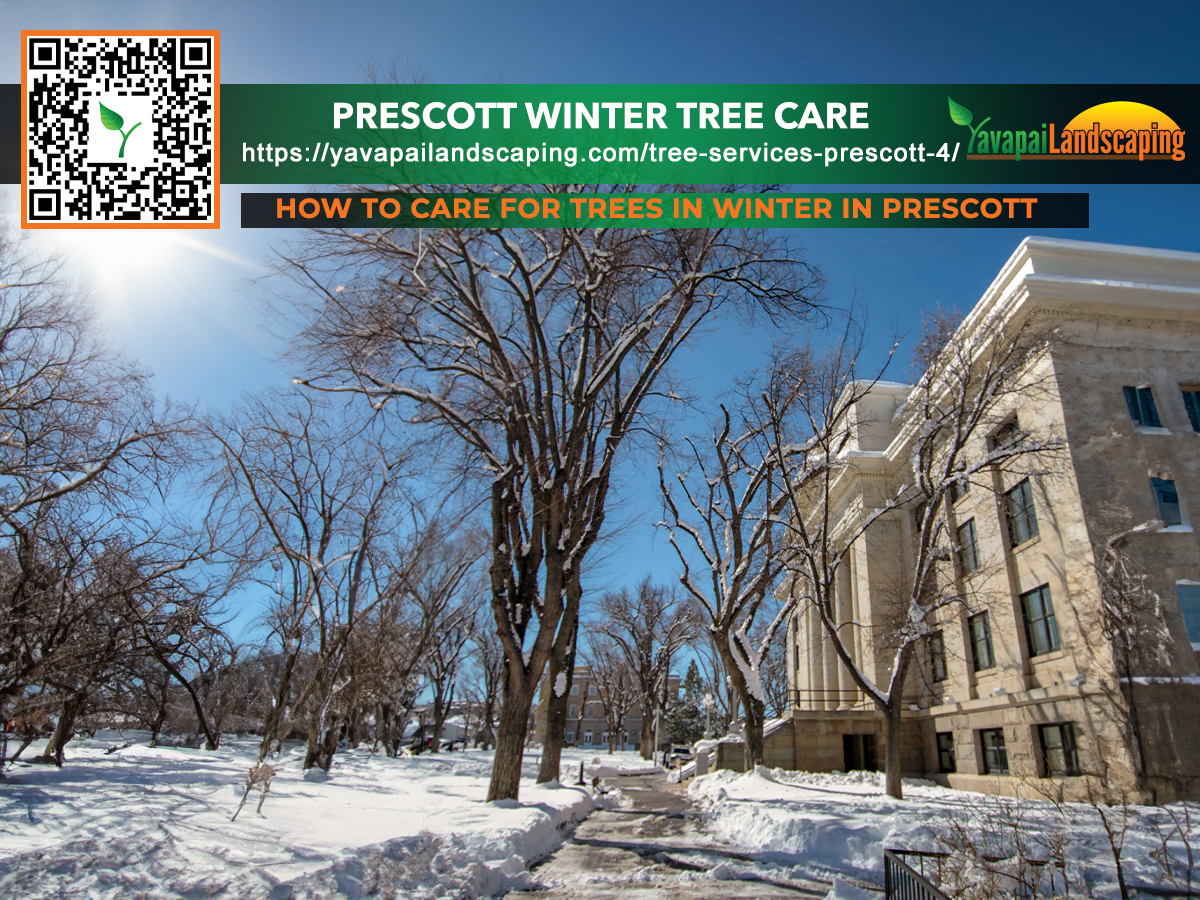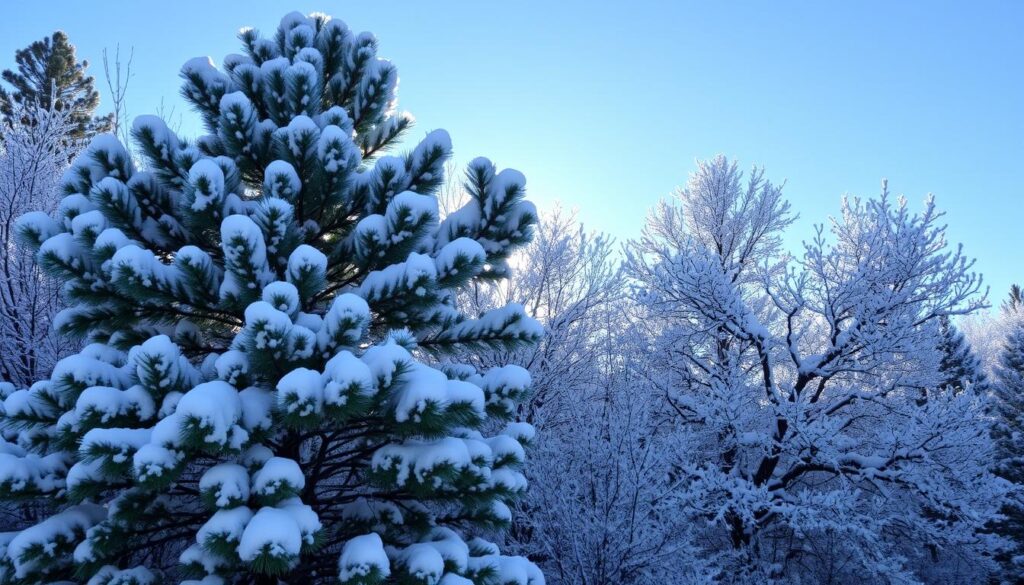
Prescott, Arizona, faces unique challenges in winter tree care. The city’s harsh weather requires new ways to protect trees. Tree care experts in Prescott are using advanced techniques to keep trees healthy and alive.
Arborists in Prescott are using new strategies to care for trees. They focus on protecting roots, using smart monitoring systems, and creating custom care plans. This mix of local knowledge and modern tech is changing how Prescott’s trees are cared for in winter.
Key Takeaways
- Prescott’s unique climate requires specialized winter tree care techniques
- Innovative approaches focus on adapting to local weather patterns
- Advanced root protection methods are crucial for tree survival
- Smart monitoring systems help track tree health in real-time
- Tailored maintenance schedules optimize care for different tree species
- Combining local expertise with modern technology enhances tree care efficiency

Understanding Prescott’s Unique Winter Climate Challenges
Prescott’s climate is tough on trees in winter. The city’s high elevation and location lead to special weather patterns. These patterns affect the local plants. To keep trees healthy, new tree care methods are needed.
Temperature Fluctuations and Tree Impact
Winter in Prescott sees big temperature changes. Days can be up to 60°F, but nights can drop below freezing. These changes stress trees, causing damage like bark splits and frost.
Tree care in winter must handle these quick changes. This helps protect trees that are easily hurt.
Common Weather Patterns
Prescott gets snow and ice storms in winter. Cold winds can also hit, making branches break. Trees need extra help during these times.
Innovative tree care, like pruning and bracing, helps trees stay strong. These methods are key to keeping trees safe during harsh weather.
Historical Data and Tree Survival
Looking at past winters shows how trees survive. Native trees like ponderosa pines do well in Prescott’s winters. But non-native trees need more care.
This information helps tree experts plan better care for different trees. They can focus on what each tree needs to stay healthy.
- Native trees: Higher survival rates
- Non-native species: Need extra protection
- Proper care: Increases overall survival
To care for trees well, you must understand Prescott’s winter weather. By using care methods that fit the local weather, trees can live longer and stay healthier.
Winter Tree Care Harsh Weather Solutions for Native Species
Prescott’s native trees face unique challenges during winter. Adapting harsh weather strategies helps these indigenous species thrive. Let’s explore effective winter protection methods for our local trees.

Native trees like ponderosa pines and alligator junipers have natural defenses against cold. Still, extra care boosts their resilience. Mulching around the base insulates roots from freezing temperatures. Use organic materials like wood chips or pine needles for best results.
Watering before the ground freezes is crucial. Deep, infrequent watering encourages roots to grow deeper, increasing drought tolerance. This practice protects trees from winter desiccation when soil moisture is limited.
- Wrap young or thin-barked trees with burlap or tree wrap
- Install windbreaks to shield trees from harsh winds
- Prune dead or diseased branches to prevent winter damage
For deciduous natives like Gambel oaks, avoid fertilizing late in the season. This prevents new growth that could be damaged by early frosts. Instead, focus on structural pruning to improve branch strength against snow loads.
Remember, each species has unique needs. Tailor your winter protection strategies to the specific requirements of your native trees. With proper care, Prescott’s indigenous trees can weather even the harshest winters.
Advanced Protection Methods for Cold-Sensitive Trees
Keeping cold-sensitive trees safe in harsh winters needs new tree care ideas. In Prescott, AZ, tree experts use the latest methods to protect these trees. They mix new tech with old ways for the best winter protection.
Modern Insulation Techniques and Materials
New insulation materials give cold-sensitive trees better protection. Stuff like breathable fabrics and foam wraps keep out cold while letting air in. They stop moisture and frost damage, keeping bark and branches safe.
Smart Temperature Monitoring Systems
Digital sensors are key in winter tree care now. They watch temperature and soil moisture changes live. When danger comes, tree experts get alerts to act fast, saving trees from frost damage.
Wind Protection Strategies and Implementation
Wind can make cold damage worse for trees. New windbreaks made from synthetic materials protect trees without blocking sunlight. They also let air move freely. For bigger areas, planting hardy evergreens creates natural barriers against wind.
Tree care pros in Prescott use these new methods to keep cold-sensitive trees safe all winter. These smart ways not only protect trees but also help forests stay healthy for a long time.
Soil Management and Root Protection Innovations
Winter tree care in Prescott, AZ needs new soil management ways. The cold weather can harm tree roots. So, protecting them is key. New methods keep soil healthy and roots safe in the cold.

One new method uses special mulch blends. These mulches keep the soil warm and moist. They also give nutrients slowly, helping roots stay healthy all winter.
Root protection has also improved. Now, breathable fabric barriers protect roots from cold. They let air and water in, preventing frost heave in Prescott’s changing winter weather.
- Smart soil sensors monitor moisture and nutrient levels
- Organic soil amendments boost microbial activity in cold conditions
- Targeted root zone heating systems for sensitive species
Soil aeration has also changed for winter. New tools make channels in frozen ground. This improves drainage and oxygen to roots, reducing waterlogging when snow melts.
Prescott arborists now use special liquid soil treatments for cold weather. These treatments go deep into the soil, giving roots the nutrients they need. They help trees fight off winter stress.
By using these new soil and root protection methods, Prescott residents can keep their trees healthy all winter. Good care in the cold months means strong growth in spring.
Technology-Driven Tree Monitoring and Maintenance
Tree monitoring technology has changed winter tree care in Prescott, AZ. Arborists now use advanced tools to track tree health. They can quickly respond to any issues. This helps trees survive harsh winters and thrive all year.
Remote Sensing for Tree Health
Remote sensing uses satellites and drones to check tree health over big areas. It spots changes in foliage color, density, and temperature. Arborists can find signs of stress or disease early.
Digital Tracking of Winter Stress Indicators
Sensors on trees measure important signs like sap flow and moisture levels. They send data to arborists in real time. This alerts them to winter stress early, preventing damage.
Automated Tree Care Systems
Automated irrigation systems adjust watering based on weather and soil moisture. They make sure trees get enough water in dry winters. Some systems even have heaters to protect roots from cold.
By using these technologies, tree care in Prescott gets better and more efficient. This proactive care keeps the urban forest healthy all winter.
Emergency Response Protocols for Severe Weather Events
When winter storms hit Prescott, quick action is key. Tree emergency protocols protect our green spaces from harsh weather. A good severe weather response can save or lose valuable trees.
Prepare for winter storms by following these steps:
- Inspect trees regularly for weak branches
- Prune dead or damaged limbs before storms hit
- Support young trees with stakes or guy wires
- Apply mulch to protect roots from freezing
During severe weather, safety is the top priority. Stay indoors and avoid trees until the storm passes. After the storm, check the damage and act:
- Remove fallen branches and debris
- Check for split trunks or uprooted trees
- Prune broken limbs to prevent further damage
- Contact a professional for large-scale repairs
Good winter tree maintenance means having a plan. Make an emergency contact list with local arborists and city officials. Keep tools like pruning shears, rope, and a first-aid kit ready. Being prepared helps minimize damage and keeps trees healthy through tough winter storms. Discover the awesomeness of this article
Sustainable Winter Pruning and Maintenance Techniques
Winter tree care is key for your trees’ health. Using sustainable pruning keeps them strong in cold months. Let’s look at good ways to care for trees in the cold.
Timing-Based Pruning Strategies
Pruning in winter is good for many trees. It’s easier to see the tree’s shape without leaves. This makes for more accurate cuts.
Try to prune when it’s warmer than freezing. This helps the tree heal faster and reduces stress.
Tool Selection for Winter Conditions
Choosing the right tools for winter pruning is important. Use clean, sharp shears and saws. Clean tools between trees to stop disease spread.
For big branches, use loppers or a pruning saw. Don’t prune when tools are wet or icy. This can harm the tree.
Post-Pruning Care in Cold Weather
After pruning, taking care of your tree is crucial. Don’t use pruning paint or sealants. Trees heal better on their own, even in winter.
Remove pruned material to stop disease. Water the tree if the ground isn’t frozen. This helps it recover and get ready for spring.
By using these sustainable pruning methods, your trees will stay healthy through winter. Good winter care means they’ll grow well in the spring.
Professional Tree Care Services and Seasonal Planning
In Prescott, AZ, tree care services are vital for winter. Experts offer custom solutions to keep trees safe from harsh weather. They use the latest tools and techniques to keep your trees healthy all winter.
Seasonal planning is crucial for tree care. Working with certified arborists helps plan care for all seasons. They check each tree’s needs and create special care plans. This helps prevent many winter problems.
Tree care experts use special strategies for Prescott’s climate. They protect trees from cold, wind, and snow. They apply coatings, install barriers, and give extra nutrients to help trees stay strong.
Team up with tree care experts to keep your trees healthy in winter. Regular checks and quick actions by pros can greatly improve your trees’ health and look.
Yavapai Landscaping Prescott offers no-cost estimates for their landscaping and tree services for Prescott and the neighboring regions. This includes tree elimination, pruning, stump grinding, land clearance, storm clean-up, and emergency tree care.
